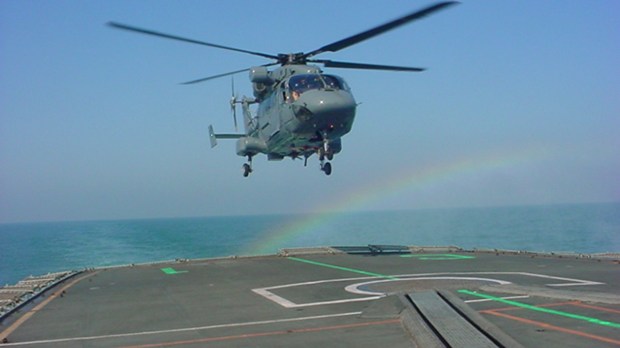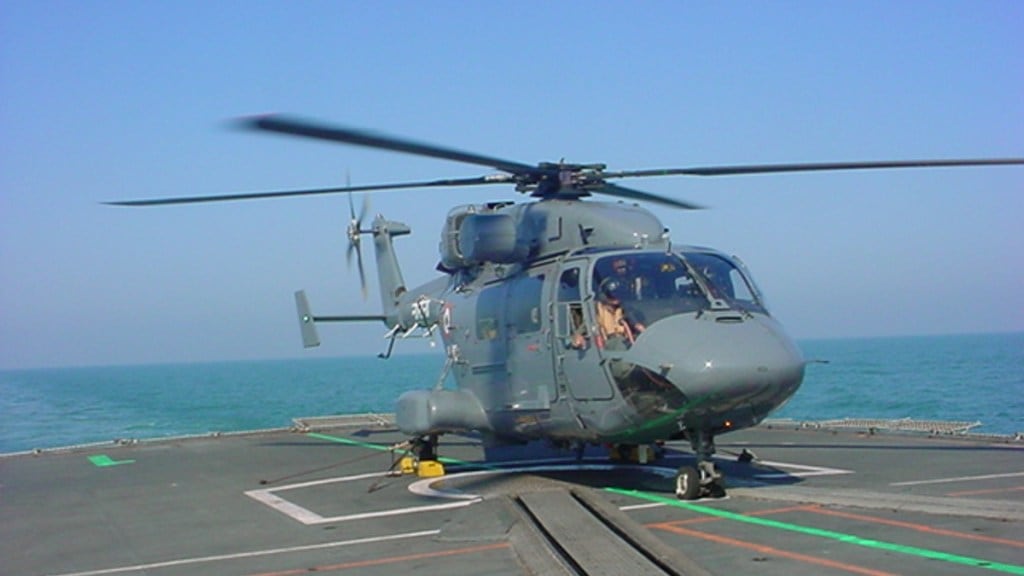Commander Yashodhan Marathe, NM (Retd)
Images of the ditched Naval ALH IN709 floating on the water last month brought a lump to my throat. My unit the ALH Flight was supposed to have accepted that helicopter in 2008, but further acquisition was put on hold since the Navy didn’t find the ALH was yet up to the mark for shipborne utilisation.
Having commanded the ALH unit in the Navy between 2005 – 2008 I was closely associated with Hindustan Aeronautics Limited (HAL) during those crucial years. All of us were proud to be flying the first Indian built helicopter, keen to take it to the limits and define operational parameters. The first big sign of trouble was in Nov 2005 when the HAL pilots ferrying the civil ALH crash-landed near Hyderabad because the tail rotor had sheared off. Signs of this failure were clearly seen earlier during our embarkation on the Carrier in 2005. HAL chose to “replace and fly” our damaged tail rotor, rather than do a thorough study and get to the root of the problem.
Any new aircraft indeed takes years of development to reach an acceptable level of safety, reliability and comfort (or operational readiness) in that order of importance. Safety is the absolute, unquestionable parameter that must be ensured prior to releasing any flying machine for operations.
Hindustan Aeronautics Limited is not new to the aerospace sector. The HF 24 Marut, HT-2, HPT-32 and Kiran are all in-house HAL designs. Chetak / Cheetah and the MiG variants were ‘built’ by HAL for many decades. The first ALH was handed over to the Navy in 2003; almost 300 Dhruvs have been produced and HAL cannot live under the ‘development umbrella’ any longer. Far too many crashes with loss of life in the fleet caused by basic airframe issues is completely unacceptable.
Problems with the initial Limited Series Production models, like MGB rejections, rainwater pouring inside the cockpit, airframe parts flying off, etc should have been fixed before going into Series Production. Many of these related to both design and quality of workmanship so this is unlikely to have changed. HAL’s claim that all problems are fixed does not inspire confidence because of continued accidents and quality issues even on the new machines. There must have been many near-accidents in which the helicopter was not a write-off due to sheer providence and so these will never come to light. The last two crashes in quick succession on 08 and 26 March are new frames of the Mark III variant that too with very little flying on them. The ICG has a maintenance/parts support contract with HAL and multiple replacement of major or dynamic components in their helicopters may go unreported. HAL has been promising capabilities that cannot be achieved within the timeframe. A glaring example is the basic design requirement of four-blade folding that was promised since 2003, but never successfully proven to the Navy after 20 years!
Ecuador rejected the ALH after four crashes. Israel returned the aircraft jointly operated by HAL and IAI. Closer to home, the ONGC too isn’t flying the ALHs they bought. While every entity that has a choice is busy rejecting the aircraft, it appears that only the Armed forces are unable to do this despite massive safety and quality issues. The fact is, HAL has never produced any machine in quantity that stands the stringent test of profitable commercial operations. To put things in perspective, many civil operators have only one helicopter in a base. They just cannot suffer the kind of extended down time that comes with an ALH due to defects. There is no ‘standby’ helicopter which the operator can afford. Carrying fare-paying passengers with tight itineraries makes every flight a Very Important flight in that sense. There is a big difference between ‘despatch reliability’ and ‘serviceability’. Although the term Despatch Reliability usually refers to scheduled flights, here it is being taken to mean the number of times or days a helicopter was started up and did not cancel the flight due to defects. A military helicopter counts as serviceable over a weekend even if it is not flown, unless there was a recorded defect. So if on a Monday, a sortie is cancelled due to a defect, the weekend dates still count as two serviceable days, thereby skewing the real picture – but dispatch reliability was indeed zero on that day. Hence ‘serviceability’ of the ALH will not be a true measure of the despatch reliability which needs to be more than 95% worldwide, with manufacturers claiming and actually providing over 98%. One realistic test of the ALH will be in Commercial Offshore operations – but can HAL rise to the challenge? Why not mandate that all PSU flights for offshore and State Government operations will only be on indigenous Dhruvs?
Serviceable Dhruvs have of course rendered yeoman service, for example, rescuing people during floods in Kerala. The problem remains safety and reliability.

What can be done?
● Basic engineering and hygiene practices must be followed for quality in manufacturing.
● HAL must listen to the customer. Any seemingly negative feedback must be taken as a challenge for improvement. Vibrations continue to plague the fleet.
● In any development every component failure, large or small, must be documented and the manufacturer must establish if failures were design issues or manufacturing problems. No such analysis has been shared. This method is very crucial for all new developments like the ALH, LCH, LUH as also fixed wing trainers and LCA.
● All the services and other operators must stand as one, share all data, and not accept any shortcomings from the OEM. Feedback was rarely seen to be actioned by HAL, and change must be forced.
● The term ‘indigenous’ must extend to mean everything produced in India, rather than only something that is designed and manufactured here. This will expand the options that can be available thereby setting up true competition and a challenge to improve. Sadly there are many within the service that push the indigenous agenda to unrealistic extents resulting in blind support to HAL from people that should actually be questioning the quality and ensuring that HAL meets standards.
● Dhruv was developed jointly with the MBB design bureau using a radical gearbox design that nobody else uses. Probably this very design applied to a 6 ton class machine, with the high hinge offset and vibrations is the source of problems. It is time to re-look and perhaps start on a blank slate with all the experience gained. This is easier said than done, but then, lives do matter. It is time to pause production, jointly audit and sort out all issues only then restart the assembly line. It is cheaper and easier to produce correctly than to produce and then correct.
● Certification and QA authorities associated with HAL must carry out stringent checks to ensure quality is maintained at all stages.
HAL should pitch their products in the highly competitive civilian market first, rather than push them down to customers whose complaints aren’t addressed in toto. Let market forces determine which is the best product. After all, even the US Army chose the European EC145 (COTS) (COTS – Commercial off-the-shelf) designated as the UH72 Lakota, over American made helicopters!
For now, the Services should appoint a combined team to audit the entire processes at HAL, consisting of people in the field. These are the people who know the issues first-hand and can pinpoint the problems. Many of these institutional problems plague not only the ALH, but also the Chetak / Cheetah fleet so the same solutions must be applied there as well. If we want real Atmanirbharta, then we must be prepared to address the harsh reality so as to rise above, find a permanent solution and succeed. I am just as keen as HAL is to see indigenous helicopters succeed –but safety has to remain at the highest Standards.
HAL also needs to realise as a company, that if they want to have a Global reach, then all these accidents across their product lines are only causing them more harm in the long term.
Hope someone is listening.
Ending with a rhyme we addressed to the Carrier after our maiden deployment onboard, many moons ago. Has anything changed?
Three Dhruvs on the mighty Carrier embarked,
For showcasing abroad, they were earmarked.
Fully charged and raring to go,
A few problems lurking, we didn’t know.
The metal hook o’the nylon lashing
Gave the EFG a good thrashing.
Two TGBs with cracks never seen
Our enthusiasm they robbed of sheen.
Sadly, by HAL we were told
We had blades that wouldn’t fold,
With the Tail Rotor rotor debonded,
All Dhruvs, sadly were grounded.
Bit by bit we worked our way,
Behind the problem, a solution lay.
Crack detections and visual inspection,
Our men ensured safety, to perfection.
To the tail rotor we added,
Many weights, nice and padded.
Ere you think we risked our necks,
We had with us, our trusty VIBREX
To all of us, this embarkation’s a first,
Many such landings do we still thirst.
Thanks to you, over many days,
Thru’ Malacca straits and other ways,
Back to the skies on ‘Indian’ wings,
A proud song to the lips this brings.
To you and to us this duty fell,
Integrating the ALH, and doing it well.
Although we might say, with a few fingers burnt,
Operating on board, we seem to have learnt.
Whilst leaving friends and saying our byes,
We wish you following seas and blue, blue skies.
The author is a QFI and retired as the Flight Commander of the ALH flight in 2008. Since then he has been flying commercially on Bell 212, Agusta A109 and Sikorsky S76D helicopters, totalling over 6,000 hours of flying since 1988. He is a designated as a Type Rated Examiner by DGCA,
Disclaimer: Views expressed are personal and do not reflect the official position or policy of Financial Express Online. Reproducing this content without permission is prohibited.
